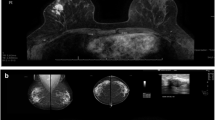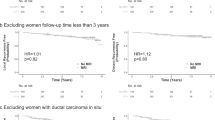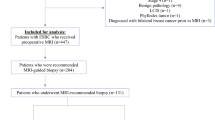Abstract
Background
Neoadjuvant chemotherapy (NCT) downstages advanced primary tumors, with magnetic resonance imaging (MRI) being the most sensitive imaging predictor of response. However, the impact of MRI evaluation on surgical treatment decisions in the neoadjuvant setting has not been well described. We report surgical patterns of care across 8 National Cancer Institute comprehensive cancer centers in women receiving both NCT and MRI to evaluate the impact of MRI findings on surgical planning.
Methods
Seven hundred seventy women from 8 institutions received NCT with MRI obtained both before and after systemic treatment. Univariate and multivariate analyses of imaging, patient-, and tumor-related covariates associated with choice of breast surgery were conducted.
Results
MRI and surgical data were available on 759 of 770 patients. A total of 345 of 759 (45 %) patients received breast-conserving surgery and 414 of 759 (55 %) received mastectomy. Mastectomy occurred more commonly in patients with incomplete MRI response versus complete (58 vs. 43 %) (p = 0.0003). On multivariate analysis, positive estrogen receptor status (p = 0.02), incomplete MRI response (p = 0.0003), higher baseline T classification (p < 0.0001), younger age (p < 0.0006), and institution (p = 0.003) were independent predictors of mastectomy. A statistically significant trend toward increasing use of mastectomy with increasing T stage at presentation (p < 0.0001) was observed in patients with incomplete response by MRI only. Among women with complete response on MRI, 43 % underwent mastectomy.
Conclusions
Within a multi-institutional cohort of women undergoing neoadjuvant treatment for breast cancer, MRI findings were not clearly associated with extent of surgery. This study shows that receptor status, T stage at diagnosis, young age, and treating institution are more significant determinants of surgical treatment choice than MRI response data.
Similar content being viewed by others
References
Blichert-Toft M, Nielsen M, During M, et al. Long-term results of breast conserving surgery vs. mastectomy for early stage invasive breast cancer: 20-year follow-up of the Danish randomized DBCG-82TM protocol. Acta Oncol. 2008;47:672–81.
Fisher B, Anderson S, Bryant J, et al. Twenty-year follow-up of a randomized trial comparing total mastectomy, lumpectomy, and lumpectomy plus irradiation for the treatment of invasive breast cancer. N Engl J Med. 2002;347:1233–41.
Jacobson JA, Danforth DN, Cowan KH, et al. Ten-year results of a comparison of conservation with mastectomy in the treatment of stage I and II breast cancer. N Engl J Med. 1995;332:907–11.
Sarrazin D, Le MG, Arriagada R, et al. Ten-year results of a randomized trial comparing a conservative treatment to mastectomy in early breast cancer. Radiother Oncol. 1989;14:177–84.
Veronesi U, Cascinelli N, Mariani L, et al. Twenty-year follow-up of a randomized study comparing breast-conserving surgery with radical mastectomy for early breast cancer. N Engl J Med. 2002;347:1227–32.
NIH consensus conference. Treatment of early-stage breast cancer. JAMA. 1991;265:391–5.
Prati R, Minami CA, Gornbein JA, Debruhl N, Chung D, Chang HR. Accuracy of clinical evaluation of locally advanced breast cancer in patients receiving neoadjuvant chemotherapy. Cancer. 2009;115:1194–202.
Wolmark N, Wang J, Mamounas E, Bryant J, Fisher B. Preoperative chemotherapy in patients with operable breast cancer: nine-year results from National Surgical Adjuvant Breast and Bowel Project B-18. J Natl Cancer Inst Monogr. 2001;30:96–102.
Mamounas EP, Brown A, Anderson S, et al. Sentinel node biopsy after neoadjuvant chemotherapy in breast cancer: results from National Surgical Adjuvant Breast and Bowel Project Protocol B-27. J Clin Oncol. 2005;23:2694–702.
Rosen EL, Blackwell KL, Baker JA, et al. Accuracy of MRI in the detection of residual breast cancer after neoadjuvant chemotherapy. Am J Roentgenol. 2003;181:1275–82.
Howlader N, Noone AM, Krapcho M, et al. SEER cancer statistics review, 1975–2009 (vintage 2009 populations). 2011.
von Minckwitz G, Untch M, Blohmer JU, et al. Definition and impact of pathologic complete response on prognosis after neoadjuvant chemotherapy in various intrinsic breast cancer subtypes. J Clin Oncol. 2012;30:1796–804.
Caudle A, Gonzalez-Angulo A, Hunt K, et al. Impact of progression during neoadjuvant chemotherapy on surgical management of breast cancer. Ann Surg Oncol. 2011;18:932–8.
Kim HJ, Im YH, Han BK, et al. Accuracy of MRI for estimating residual tumor size after neoadjuvant chemotherapy in locally advanced breast cancer: relation to response patterns on MRI. Acta Oncol. 2007;46:996–1003.
McGuire KP, Santillan AA, Kaur P, et al. Are mastectomies on the rise? A 13-year trend analysis of the selection of mastectomy versus breast conservation therapy in 5865 patients. Ann Surg Oncol. 2009;16:2682–90.
Greenberg CC, Lipsitz SR, Hughes ME, et al. Institutional variation in the surgical treatment of breast cancer: a study of the NCCN. Ann Surg. 2011;254:339–45.
Katipamula R, Degnim AC, Hoskin T, et al. Trends in mastectomy rates at the Mayo Clinic Rochester: effect of surgical year and preoperative magnetic resonance imaging. J Clin Oncol. 2009;27:4082–8.
Pettit K, Swatske ME, Gao F, et al. The impact of breast MRI on surgical decision-making: are patients at risk for mastectomy? J Surg Oncol. 2009;100:553–8.
Furman B, Gardner MS, Romilly P, et al. Effect of 0.5 tesla magnetic resonance imaging on the surgical management of breast cancer patients. Am J Surg. 2003;186:344–7.
Bilimoria KY, Cambic A, Hansen NM, Bethke KP. Evaluating the impact of preoperative breast magnetic resonance imaging on the surgical management of newly diagnosed breast cancers. Arch Surg. 2007;142:441–5.
Sorbero M, Dick A, Beckjord E, Ahrendt G. Diagnostic breast magnetic resonance imaging and contralateral prophylactic mastectomy. Ann Surg Oncol. 2009;16:1597–605.
Wolff AC, Hammond ME, Schwartz JN, et al. American Society of Clinical Oncology/College of American Pathologists guideline recommendations for human epidermal growth factor receptor 2 testing in breast cancer. J Clin Oncol. 2007;25:118–45.
Singletary SE, Allred C, Ashley P, et al. Staging system for breast cancer: revisions for the 6th edition of the AJCC Cancer Staging Manual. Surg Clin North Am. 2003;83:803–19.
Lee MC, Rogers K, Griffith K, et al. Determinants of breast conservation rates: reasons for mastectomy at a comprehensive cancer center. Breast J. 2009;15:34–40.
Spanheimer PM, Carr JC, Thomas A, et al. The response to neoadjuvant chemotherapy predicts clinical outcome and increases breast conservation in advanced breast cancer. Am J Surg. 2013;206:2–7.
McGuire KP, Toro-Burguete J, Dang H, et al. MRI staging after neoadjuvant chemotherapy for breast cancer: does tumor biology affect accuracy? Ann Surg Oncol. 2011;18:3149–54.
Adkisson C, Vallow L, Kowalchik K, et al. Patient age and preoperative breast MRI in women with breast cancer: biopsy and surgical implications. Ann Surg Oncol. 2011;18:1678–83.
Mamounas EP, Anderson SJ, Dignam JJ, et al. Predictors of locoregional recurrence after neoadjuvant chemotherapy: results from combined analysis of National Surgical Adjuvant Breast and Bowel Project B-18 and B-27. J Clin Oncol. 2012;30:3960–6.
Mittendorf EA, Buchholz TA, Tucker SL, et al. Impact of chemotherapy sequencing on local-regional failure risk in breast cancer patients undergoing breast-conserving therapy. Ann Surg. 2013;257:173–9.
Smith RA. The evolving role of MRI in the detection and evaluation of breast cancer. N Engl J Med. 2007;356:1362–4.
Houssami N, Ciatto S, Macaskill P, et al. Accuracy and surgical impact of magnetic resonance imaging in breast cancer staging: systematic review and meta-analysis in detection of multifocal and multicentric cancer. J Clin Oncol. 2008;26:3248–58.
Furman B, Gardner MS, Romilly P, et al. Effect of 0.5 tesla magnetic resonance imaging on the surgical management of breast cancer patients. Am J Surg. 2003;186:344–7.
Berg WA, Gutierrez L, NessAiver MS, et al. Diagnostic accuracy of mammography, clinical examination, US, and MR imaging in preoperative assessment of breast cancer. Radiology. 2004;233:830–49.
Bilimoria KY, Cambic A, Hansen NM, Bethke KP. Evaluating the impact of preoperative breast magnetic resonance imaging on the surgical management of newly diagnosed breast cancers. Arch Surg. 2007;142:441–5.
Grobmyer SR, Mortellaro VE, Marshall J, et al. Is there a role for routine use of MRI in selection of patients for breast-conserving cancer therapy? J Am Coll Surg. 2008;206:1045–50.
Itakura K, Lessing J, Sakata T, et al. The impact of preoperative magnetic resonance imaging on surgical treatment and outcomes for ductal carcinoma in situ. Clin Breast Cancer. 2011;11:33–8.
Hiotis K, Ye W, Sposto R, Skinner KA. Predictors of breast conservation therapy: size is not all that matters. Cancer. 2005;103:892–9.
Bhattacharyya M, Ryan D, Carpenter R, Vinnicombe S, Gallagher CJ. Using MRI to plan breast-conserving surgery following neoadjuvant chemotherapy for early breast cancer. Br J Cancer. 2008;98:289–93.
Partridge SC, Gibbs JE, Lu Y, et al. MRI measurements of breast tumor volume predict response to neoadjuvant chemotherapy and recurrence-free survival. AJR Am J Roentgenol. 2005;184:1774–81.
De Los Santos JF, Cantor A, Amos KD, et al. Magnetic resonance imaging as a predictor of pathologic response in patients treated with neoadjuvant systemic treatment for operable breast cancer: Translational Breast Cancer Research Consortium trial 017. Cancer. 2013;119:1776–83.
Acknowledgments
We are grateful to all of the patients who were included in this study and to the Translational Breast Cancer Research Consortium investigators and data managers for their efforts. We are very appreciative of funding support from the Translational Breast Cancer Research Consortium from the AVON Foundation, the Breast Cancer Research Foundation, and Susan G. Komen for the Cure. We gratefully acknowledge the American College of Radiology Imaging Network (ACRIN) for granting permission to include patients who were treated on the ACRIN 6657/I-SPY Trial (supported by National Cancer Institute grants U01 CA079778 and U01 CA080098).
Disclosure
The authors declare no conflict of interest.
Author information
Authors and Affiliations
Corresponding author
Additional information
On behalf of Translational Breast Cancer Research Consortium.
Rights and permissions
About this article
Cite this article
McGuire, K.P., Hwang, E.S., Cantor, A. et al. Surgical Patterns of Care in Patients with Invasive Breast Cancer Treated with Neoadjuvant Systemic Therapy and Breast Magnetic Resonance Imaging: Results of a Secondary Analysis of TBCRC 017. Ann Surg Oncol 22, 75–81 (2015). https://doi.org/10.1245/s10434-014-3948-3
Received:
Published:
Issue Date:
DOI: https://doi.org/10.1245/s10434-014-3948-3




